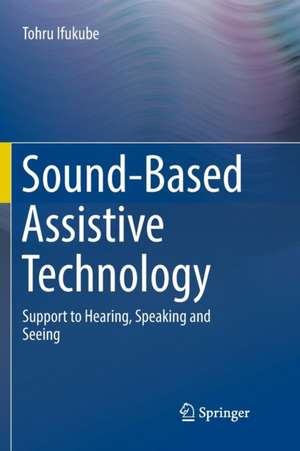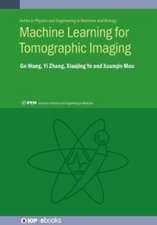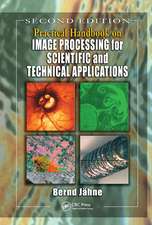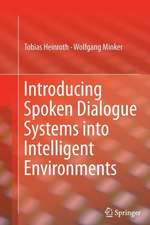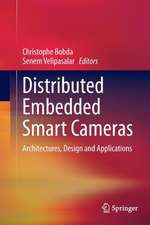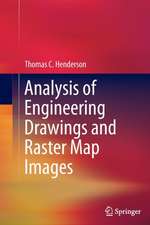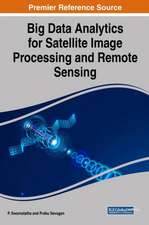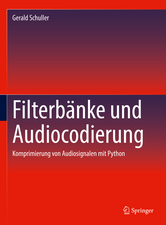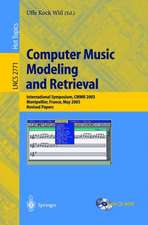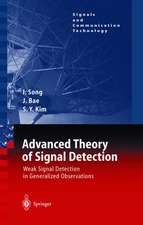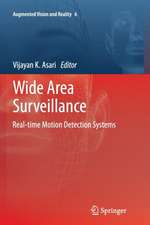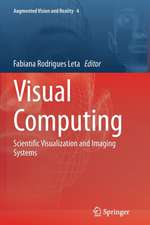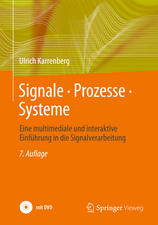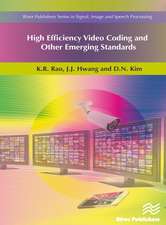Sound-Based Assistive Technology: Support to Hearing, Speaking and Seeing
Autor Tohru Ifukubeen Limba Engleză Paperback – 20 iul 2018
| Toate formatele și edițiile | Preț | Express |
|---|---|---|
| Paperback (1) | 779.08 lei 43-57 zile | |
| Springer International Publishing – 20 iul 2018 | 779.08 lei 43-57 zile | |
| Hardback (1) | 785.11 lei 43-57 zile | |
| Springer International Publishing – 15 mar 2017 | 785.11 lei 43-57 zile |
Preț: 779.08 lei
Preț vechi: 950.09 lei
-18% Nou
Puncte Express: 1169
Preț estimativ în valută:
149.09€ • 154.71$ • 124.62£
149.09€ • 154.71$ • 124.62£
Carte tipărită la comandă
Livrare economică 17-31 martie
Preluare comenzi: 021 569.72.76
Specificații
ISBN-13: 9783319838755
ISBN-10: 331983875X
Ilustrații: XII, 239 p. 196 illus., 11 illus. in color.
Dimensiuni: 155 x 235 mm
Greutate: 0.36 kg
Ediția:Softcover reprint of the original 1st ed. 2017
Editura: Springer International Publishing
Colecția Springer
Locul publicării:Cham, Switzerland
ISBN-10: 331983875X
Ilustrații: XII, 239 p. 196 illus., 11 illus. in color.
Dimensiuni: 155 x 235 mm
Greutate: 0.36 kg
Ediția:Softcover reprint of the original 1st ed. 2017
Editura: Springer International Publishing
Colecția Springer
Locul publicării:Cham, Switzerland
Cuprins
Basis for Sound-Based Assistive Technology.- Sound Signal Processing for Auditory Aids.- Functional Electrical Stimulation to Auditory Nerves.- Tactile Stimulation Methods for the Deaf and/or Blind.- Speech Recognition Systems for the Hearing Impaired and the Elderly.- Assistive Tool Design for Speech Production Disorders.- Sound Information Aiding for the Visually Impaired.
Recenzii
“This book is recommended for any individual who is interested in learning more about assistive technology and has limited prior knowledge. … this book provides a short overview of the subject matter and will lead the reader in the right direction to related works.” (Richard Burns, Computing Reviews, February, 7, 2018)
Notă biografică
Tohru Ifukube received the MS and D.Eng degrees in electronics from Hokkaido University in 1971 and 1977, respectively. He joined the laboratory of Medical Electronics, Research Institute of Applied Electricity, Hokkaido University, in 1971.He was also a visiting Associate Professor at Stanford University, CA in 1984.
He was a professor of the Medical Electronics Laboratory and Sensory Information Laboratory at the Research Institute for Electronic Science, Hokkaido University from 1989 to 2002.
He was a professor at the Research Center for Advanced Science and Technology, University of Tokyo until 2010. He is a professor of Hokkaido University of Science and also a research fellow at Institute of Gerontology at the University of Tokyo. He is a professor emeritus of both Hokkaido University and the University of Tokyo. His research interests include the analysis of the human sensory functions and the design of sensory aid devices. Some of these devices have been used for the blind as well as the deaf, and also have been applied to virtual reality and robotic systems.
Fellow: Institute of Electronics, Information, and Communication (2002), Fellow (2011) and President (2012-2013): Virtual Reality Society of Japan, Awards: Established Lifetime Achievement Award of the Robotics Society of Japan (2010), Nakayama Award Grand Prize (for Human Science, 2010), Masters honoring of sound (for Earthquake Early Warning Chime, 2012), Hokkaido News Paper Prize (for Assistive Technology, 2014) .
He is research leader and selection committee of many national project such as a Program Officer “Design of Technology and systems for super-aged society“ of JST (Japan Science and Technology Agency), a selection committee chairman of “ Information barrier-free project“ (Ministry of Internal Affairs and Communications) and a selection committee of “Aids for hearing and seeing“ (Ministry of Health, Labour and Welfare).
He was a professor of the Medical Electronics Laboratory and Sensory Information Laboratory at the Research Institute for Electronic Science, Hokkaido University from 1989 to 2002.
He was a professor at the Research Center for Advanced Science and Technology, University of Tokyo until 2010. He is a professor of Hokkaido University of Science and also a research fellow at Institute of Gerontology at the University of Tokyo. He is a professor emeritus of both Hokkaido University and the University of Tokyo. His research interests include the analysis of the human sensory functions and the design of sensory aid devices. Some of these devices have been used for the blind as well as the deaf, and also have been applied to virtual reality and robotic systems.
Fellow: Institute of Electronics, Information, and Communication (2002), Fellow (2011) and President (2012-2013): Virtual Reality Society of Japan, Awards: Established Lifetime Achievement Award of the Robotics Society of Japan (2010), Nakayama Award Grand Prize (for Human Science, 2010), Masters honoring of sound (for Earthquake Early Warning Chime, 2012), Hokkaido News Paper Prize (for Assistive Technology, 2014) .
He is research leader and selection committee of many national project such as a Program Officer “Design of Technology and systems for super-aged society“ of JST (Japan Science and Technology Agency), a selection committee chairman of “ Information barrier-free project“ (Ministry of Internal Affairs and Communications) and a selection committee of “Aids for hearing and seeing“ (Ministry of Health, Labour and Welfare).
Textul de pe ultima copertă
This book "Sound-based Assistive Technology" explains a technology to help speech-, hearing- and sight-impaired people. They might benefit in some way from an enhancement in their ability to recognize and produce speech or to detect sounds in their surroundings. Additionally, it is considered how sound-based assistive technology might be applied to the areas of speech recognition, speech synthesis, environmental recognition, virtual reality and robots. It is the primary focus of this book to provide an understanding of both the methodology and basic concepts of assistive technology rather than listing the variety of assistive devices developed in Japan or other countries. Although this book presents a number of different topics, they are sufficiently independent from one another that the reader may begin at any chapter without experiencing confusion. It should be acknowledged that much of the research quoted in this book was conducted in the author's laboratories both at Hokkaido University and the University of Tokyo. This book offers the reader a better understanding of the number of unsolved problems that still persist in the field of sound-based assistive technology.
Caracteristici
Deals with information communication technology contributing to supporting the aging society as well as the sensory and communication disabled Provides new insights into the human senses and the brain functions concerning communication and environment recognition Includes a lot of hints to produce the new VR (Virtual Reality) technologies and communication robots Includes supplementary material: sn.pub/extras
